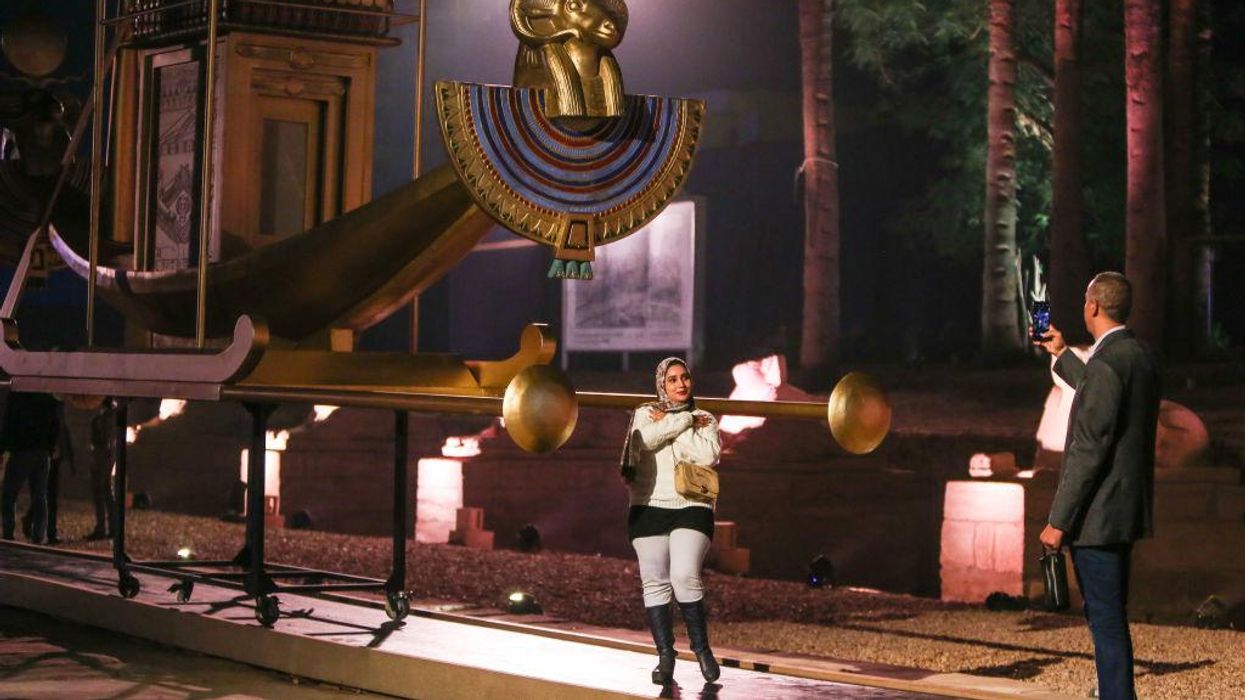
Islam Safwat/Getty Images

Egyptian authorities on Thursday reopened a 3,000-year-old sphinx-lined avenue connecting two ancient temples in the city of Luxor.
With great fanfare and festivities, the restored Avenue of the Sphinxes was opened to the public after nearly a half century of archaeological excavation. The almost two-miles long and 250 foot wide pathway, once called "The Path of Gods," connects the ancient Temple of Luxor with the Temple of Karnak in what was once the city of Thebes, the kingdom's repeat capital in antiquity. The site is located on the banks of the Nile River, about 400 miles south of Cairo.
The road was once lined with about 1,300 sphinx and ram-headed statues in rows on each side, though now only about 300 of the original statues remain, according to Egypt Today. The statues were each carved from a single block of sandstone and were inscribed with the king's name and titles.
The ruins of the path were discovered by Egyptian archaeologist Zakaria Ghineim, who found the first eight sphinx statues in front of the Luxor Temple in 1949.
Since then, Egyptian authorities have worked to excavate and restore the site, though political upheaval such as the 2011 Arab Spring uprising and the overthrow of former President Hosni Mubarak interrupted the work.
"Tonight I will be witnessing one of the greatest events that has ever happened in my lifetime," said Ahmed Hammam, a Luxor tour guide, in an interview with NBC News.
The 47-year-old Egyptian said seeing the restoration of the Avenue of Sphinxes come to completion was "like a dream."
"Today will be a day we will talk about for a hundred years to come," said Hammam. "I hope everybody will enjoy it. Not just here in my hometown city, but in the whole of Egypt, and the whole of the world as well."
The grand opening ceremony featured performers dressed in ancient garb, pharaonic chariots, lights, and music in a re-enactment of the Opet Festival — an annual ancient celebration held to promote the fertility of the god-king Amun-Re and the Pharaoh, who was believed to be his spiritual offspring.
Egypt reopens ancient Luxor's 'Avenue of the Sphinxes' with fireworks and grand parade \n\nhttps://bbc.in/3CSJetb\u00a0pic.twitter.com/VWOUv0aWhX— BBC News (World) (@BBC News (World)) 1637893806
Men dressed in sheer gold and black robes carried three golden, pharaonic-style model boats down the avenue, one dedicated to the ancient sun god AmunRa, one to the moon god Khonsu, and the third to the mother goddess Mut.
[twitter_embed https://twitter.com/disclosetv/statuses/1463945558587068422 iframe_id="twitter-embed-1463945558587068422" created_ts="1637866794" name="Disclose.tv" embed_mobile_width="375" text="NOW - Egypt reopens the 1.7-mile long "Avenue of Sphinxes" that links the ancient Egyptian temples of Luxor and Karnak.pic.twitter.com/6BIIybjIyj" embed_desktop_height="575" embed_desktop_width="550" embed_mobile_height="501" id="1463945558587068422" expand="1" screen_name="disclosetv"]Egyptian President Abdel Fatah el-Sissi attended the celebration, with other senior officials from the government.
The lavish celebration was held in part to rekindle foreign interest in visiting Egypt, after the COVID-19 pandemic dealt a major blow to the tourism industry. According to Reuters, Egypt's tourism revenues fell to about $4 billion in 2020, down from $13 billion in 2019.
Officials said the event was intended to show off the monuments in Luxor, calling the city the "biggest open museum in the world."
Antiquities minister Khaled el-Anani said archaeologists are still working to unearth more statues and other buried ruins of the ancient world, ABC News reports.